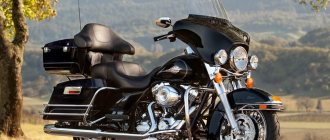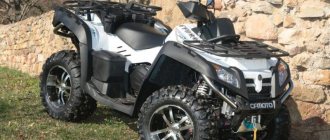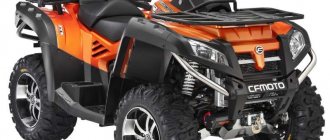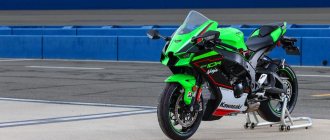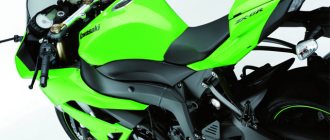You are walking down the street and suddenly hear a muffled roar. The sound grows and gets closer, and then a green motorcycle rushes past you at breakneck speed, flashing into your field of vision for a split second, literally flying over the road, shaking the surroundings with the roar of the engine and leaving a black trace of burnt rubber on the asphalt behind it. Impressive? Still would! Now imagine what emotions the person driving this plastic rocket, whose name is Kawasaki Z800, experiences at this moment?
The reference city bike for the most desperate motorcyclists
If a motorcycle is more than a utilitarian means of transportation for you, if you are partial to speed and the sensations it gives, if you love the best, then the Kawasaki Z800 is your choice. In this remarkable representative of the two-wheeled urban fauna, all the technological innovations of the Japanese concern, which is famous for its sportbikes, have found their application, and the designers gave it predatory and swift outlines, thanks to which the motorcycle in question immediately stands out in city traffic. The Z800, driven by a skilled biker, easily and naturally pierces the bustle of the city, standing out from the rest of the road users, like a shark among small fish.
Of course, such power imposes certain obligations and requires a very careful approach. There may be more powerful motorcycles in the world, but the Kawasaki Z800 technical characteristics allow it to develop breathtaking speed in a frighteningly short period of time. The Kawasaki Z750 replacement was launched in 2013 to break into the 800cc road bike scene from Suzuki and Yamaha, and is positioned as a powerful city bike for experienced riders. In addition, the forced engine of the Z800 has a very nervous character with pronounced dips and kicks, which can present an unpleasant surprise to an insufficiently experienced driver. No, it’s definitely not worth boarding this rocket without having solid experience behind you - it could end very badly. To curb the frantic nature of this representative of the Z-series, you will have to try hard.
Is it worth buying a Kawasaki Z800?
The unusual Japanese “naked” is in that category of bikes in which there can be no outright mistakes in principle. The choice of one model or another comes down to studying the subject with a magnifying glass and taking into account the personal whims of the potential buyer. Among the most obvious advantages of the Kawasaki Z800 it is worth highlighting:
- aggressive exterior (can be considered a disadvantage depending on taste);
- powerful and reliable engine;
- high controllability and maneuverability;
- reasonable price;
- excellent acceleration dynamics.
Characteristics and parameters
The main advantage of the 800cc streetfighter is undoubtedly its engine. A modern liquid-cooled inline-four produces 113 hp. and 83 nM of torque (although there is also a “strangled” modification - Z800E, with 95 hp of power and 76 nM of torque, respectively). The character of the Kawasaki engine is obvious - it only fully opens up at high revs, and when the tachometer needle crosses the 8000 rpm mark, the Kawasaki gets a second wind. There is a downside to this - in the lower rev range the bike reacts very sharply to the slightest turn of the throttle, which makes driving through city traffic jams somewhat difficult. Fortunately, the tenacious petal disc brakes are extremely effective in stopping a motorcycle that has accelerated, and the manufacturer also offers ABS as an additional option.
The combination of hurricane-force acceleration dynamics and grippy brakes is great, but the Kawasaki Z800's technical characteristics stand out from its competitors due to the fact that this bike is equipped with excellent suspensions. At the front there is a short-stroke inverted fork with adjustable preload and rebound, and at the rear there is a gas shock absorber from the renowned manufacturer Uni-Trak, adjustable for rebound and compression. In general, the Kawasaki suspension is quite stiff, that is, exactly what it should be on a motorcycle designed for aggressive riding - it does not prohibit sharp maneuvers and cornering with a knee. But it’s worth considering that in this mode, the Kawasaki Z800 will consume huge amounts of gasoline, despite the fact that during quiet driving it is very economical, and the 17-liter gas tank provides it with an excellent power reserve without refueling. But who rides calmly on a motorcycle that can accelerate to 100 km/h in 3.3 seconds?
The maximum speed of the Z800 is 230 km/h, but due to the lack of any sane wind protection, the headwind will begin to bother you much earlier - it causes discomfort already at 130-140 km/h. The seating position is quite classic, comfortable for most motorcyclists, regardless of their size. The seat is hard, but comfortable and not at all slippery. And in any case, we should not forget that this bike was created not for comfort, but for pleasure.
KAWASAKI Z800 – TEST
Text: Vladimir Zdorov
Photo: Nikita Kolobanov
>>In 1972, the company introduced the Kawasaki Z1 to the world public - at that time a real showstopper, the ultimate road motorcycle with fantastic characteristics. Of course, the world was not blown up, because Honda did something similar with its CB750 back in 1969. However, it was the letter Z that became an icon for a whole generation of motorcycles that personified naked, primitive power! Remember what kind of motorcycle the then little-known Australian native Mel Gibson rode in the then cult movie Mad Max? That's right - on a 1977 Kawasaki KZ1000...
Nostalgia
Yes, now I’ll start a favorite old man’s song that in those days cars were cars, the grass, of course, was greener, and women... But try to argue with me? The cars were truly “real” - huge multi-liter mastodons with V-shaped eights with 7 liters of displacement, with endless hoods and interiors of such dimensions that a modern small car could easily fit in and still have room. As for grass, compare the environmental situation in the mid-70s and now... For women, my arguments are unlikely to be so convincing, however, this is a completely different story for another magazine... Let's return to our “green”, in our case – black and white . Of course, the new Kawasaki Z800 model, which “grew” from the 750 cc version, is unlikely to ever be able to gain the glory and greatness of that “correct” Z series, which appeared, scary to say, even before I was born. But the designers, engineers and designers did everything to get away from the image of a plush green toy for office clerks - dubious dividends that the Z750 version collected in its time. This was largely due to the toothless nature of the engine, the “plasticine” suspension and the relatively soft, “friendly” design of the entire car as a whole. In the new Z800, practically nothing remains from its predecessor, except for the famous letter Z!
Fitness
It would be wrong to say that the 800 was “pulled up” from the 750 model; the motorcycle was created from scratch. Starting from a globally modified power plant with an engine displacement increased to 806 cm3, a different frame, adjustable suspensions with a front “reverse” and ending with a completely new dashboard! The ideology of the pilot’s landing position was also revised, with a noticeable emphasis on moving forward and slightly downward; the headlight also moved “downward”, noticeably “hanging” over the front fender. The result is beyond any dispute, obvious: a “frowning” look, undisguised aggression - such a tough, unambiguous bid for victory. Of course, all this does little to contribute to at least some kind of wind protection at high speeds, but, let's be honest - where can you now reach such speeds in a city agonizing over colossal traffic jams, filled with security cameras cleaner than other closed institutions? But it’s a fact that this is much more aggressive.
Corporate ethics
The designer of the new series, Keishi Fucumoto, explained that in the appearance of the Z800, the team of stylists tried to reveal how Kawasaki understands the letter Z. For the company, this is not just an alphabetic symbol, Z is an entire era, for Keishi the keyword in the project was the English ferocity - wildness, ferocity. It is in this spirit, in an attempt to express this in design, that the Kawasaki Z800 was created. I must say that there are no questions for the design team - they really “withstood” the style of the Z800 in full combination with ferocity. A little more look from the inside: Hidehiko Yamamoto - head of the engineering department about the new power plant and ergonomics: “we pushed the cylinder block forward a little to move the fuel tank and the entire pilot even lower and closer to the front wheel, shortened the gear ratios, increased rear sprocket size (from 43 to 45 teeth). Of course, the main difference is the increased engine capacity; handling and stability at high speeds have also noticeably improved thanks to the new suspensions.” The pathetic speeches of the concern's Japanese specialists are a thing of mandatory corporate ethics, otherwise they will cut off their heads. It happens that in reality you don’t understand at all what the company’s engineers were talking about at the presentation? Where is the promised power and better handling? Where have the “heavy duty” brakes gone?
However, in the case of the Z800, everything actually turned out to be quite close to the declared characteristics! The Kazan Ring track finally helped me dot all the i's, where I was surprised to discover that the Z800 really had a breakthrough in terms of chassis! No matter how hard I tried, I couldn’t get the motorcycle over the edge, after which the chassis “deflated”! Of course, you can’t expect performance and acceleration in the style of, say, a Kawasaki 636 from an engine with 113 hp. However, both the lows and the middle of this engine are, as they say, “in assortment”; one should not discount the competent operation of ABS, created in collaboration with Nissin specialists - even in the extreme modes of the track session format, I could not find it in her work has the slightest flaws.
Wheelie Factor
Motorcycles with an engine displacement of 800 cm3, in theory, should ride on the rear wheel from second gear just from the mere thought and absolutely everything, “without exception”. However, in the harsh practice of Chelyabinsk residents, there are specimens that even in first gear can hardly unload the fork even a little. But in the case of the Z800, this is not the case - here is a real “classic of the genre”: second gear and a little clutch assistance easily lift the bike into the air. However, this is far from the most important thing for the wheelie. Let's say the YZF-R6 is also capable of such a trick in second gear, but it does it so nervously and poorly controlled that every time it turns out like Russian roulette - you never know how it will end. With the Kawasaki Z800, everything is exactly the opposite: the engine’s reactions to the throttle are “transparent” and will be understandable even to pensioners in line at the savings bank for the next handout from the state, which we call a pension. The “even” response to the throttle also makes it possible to ride on the rear wheel from first gear directly “from the gas” - no hysteria and understandable reactions of the motorcycle. In this case, in addition to the precision operation of the injection system, good weight distribution of the motorcycle and an unoverloaded front part also contribute to this, which in total makes it possible to easily control the entire process - from the beginning of the climb to the landing.
Limits
If there is a sufficiently experienced pilot on the Z800, then the first thing he will “pick” from the limits is the engine. To “drive the chassis crazy” you will need something more than 113 hp. But this does not mean at all that there is “no motor” here - it’s just “in stock”; we just shouldn’t forget about the original purpose of the model - that is, primarily for urban use. And if someone tells you that they don’t have enough power on the streets, just send the person to the appropriate medical professional. Or, as an option, to the track - where, I’m sure, people will pass by even on motorcycles half the volume and power. Kawasaki Z800 is a perfectly balanced system: engine, chassis, brakes. Moreover, this system was made for the city with a fair amount of reserve, which, in the end, made it possible to feel good even on the Kazan Ring track. The maximum that the designers can be blamed for is perhaps the excessively long stops of the driver's footrests, but this “terrible problem” can be solved in less than minutes with the help of one wrench.
Good job
The combination of engine, chassis and brakes on the Z800 is in almost perfect proportion. For my taste, I would still add a little pepper to this dish: I would throw another 10-15 “horses” into the power plant. However, although this is not the most budget-friendly (the issue is solved by installing an expensive forward flow and then tuning the engine on a stand), it is quite a workable option - since, judging by the slightly muffled hiss of the stock exhaust system, environmentalists have ruined more than one herd of horses there. Another disadvantage of such silence is less visibility for motorists who are obviously already born deaf. By the way, about the city: it’s impossible to come up with any other negative in relation to the Z800 in the format of concrete labyrinths. The seat is comfortable for both the driver and the passenger, more is visible in the mirrors than necessary, vibrations from the engine “dissolve” somewhere deep in the bowels of the motorcycle. The only thing is that it would be nice to lose ten kilograms from the curb weight, but this option will automatically drag the price tag upward. But, besides all the others, this is another and very serious argument of the heir and successor of the Z series...
Reviews from real owners
I bought a Z800 with 12 thousand miles, before that I drove a Yamaha FZ6 for two years and a Honda CB400 for a year. To be honest, after the first trip I got off the bike, put it in the garage and didn’t go near it for a week, because it really scared me. This is not a motorcycle, but a teleporter - you look somewhere, unscrew the right handle, and that’s it, you’re already there. Then I started driving, of course, but very carefully, and I felt like a first-season rider again. I’m completely immersed in it, the feeling the bike gives is simply indescribable, but it’s very difficult to ride it calmly, because it constantly provokes you. Sergey, St. Petersburg, Kawasaki Z800 '2014.
I read reviews on the forums about the Kawasaki Z800, decided that this was what I needed, and I was not mistaken. I sold my CBR F4i, added some money and took Cava. There are just a lot of sensations, after the CBR it’s like an airplane. The suspension is stiff, no matter how you set it, if you drive for a long time, the fifth point becomes numb. The seating position is comfortable. It’s also possible to travel long distances; when driving quietly, it consumes a little, the tank lasts 230-250 kilometers, but it’s boring to throw up like that, and you can’t take much luggage with you. Tuning on the Kawasaki Z800 is expensive, I hung plastic Chinese panniers on frames, but I’m afraid to drive quickly with them - as if the wind would blow them off. Ivan, Moscow, Kawasaki Z800 '2015.
After three years on the Zizer 400, I wanted something more powerful and something that looked more modern. The new 800 from the evergreen company came up just right, the Kawasaki Z800 has technical characteristics at the level, for the city it’s amazing for the eyes and ears, sometimes it’s even scary from what it’s capable of. I read a lot of reviews on the forums about the Kawasaki Z800 - at first I didn’t believe what the owners wrote about it. When I drove it myself, I realized that everything was true. The motorcycle is definitely not for a beginner; getting killed on it due to inexperience is a piece of cake. Not a bike, but a sports car, Formula 1 is resting. Valery, Istra, Kawasaki Z800 '2017.
Main competitors
- Yamaha FZ-8 . The Z-ki's most serious competitor, similar in price, although the Kawasaki Z800 has enough technical characteristics for a reasoned argument with it on the road. At the same time, the Yamaha has a much calmer and friendlier character, although, if necessary, it shows results that are not inferior to the Z800. The design of the FZ-8 is more classic, but also very decent. If the harshness of the Kawasaki is a negative factor for you when choosing a motorcycle, perhaps you will like the Yamaha better.
- Suzuki GSR 750, aka GSX S750 . If we compare it with analogues from Kawasaki and Yamaha, then the bike from Suzuki will be closer to the Phaser. Powerful and modern, it still doesn't have the explosive character that the Kawasaki Z800 can boast. At the same time, both in terms of dynamics and other parameters, this motorcycle can provide worthy competition to the two aforementioned rivals.
Specifications
| Maximum engine power: | 113 hp at 10200 rpm HP |
| Torque: | 83 Nm at 8000 rpm Nm |
| Working volume: | 806 cm3 |
| Motor type (cylinder arrangement, number of strokes): | In-line, 4 cylinders, 16 valves |
| Number of cylinders: | 4 |
| Number of valves: | |
| Intake type (Injector / Carburetor): | |
| Bore and stroke: | |
| Starting system (Electric starter, kick starter): | |
| Cooling system: | Liquid |
| Transmission (gearbox): | 6, Mechanical |
| Clutch (Dry / Wet): | |
| Drive unit: | Chain |
| Frame: | Steel spine |
| Chassis | |
| Suspension (front/rear travel): | |
| Brakes (Front/Rear): | |
| Wheels / Tires / Rubber: | |
| Dimensions and weight | |
| Dimensions (Length / Width): | |
| Seat height: | |
| Ground clearance: | |
| Curb weight: | |
| Wheelbase: | 1445 mm |
| Weight: | 229 kg |
| Fuel tank capacity: | 17 l. |
| Battery capacity: | |
| Year of release: | |
| Country of Origin: |

